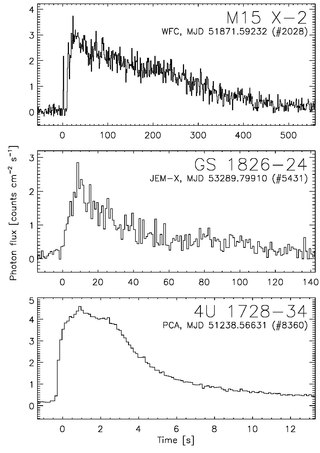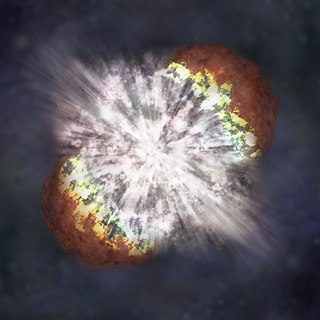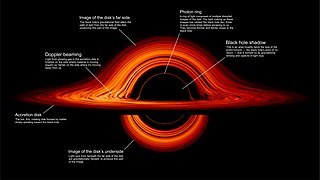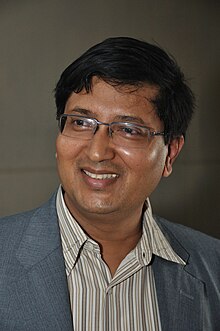
In gamma-ray astronomy, gamma-ray bursts (GRBs) are immensely energetic explosions that have been observed in distant galaxies. They are the most energetic and luminous electromagnetic events since the Big Bang. Bursts can last from ten milliseconds to several hours. After an initial flash of gamma rays, a longer-lived "afterglow" is usually emitted at longer wavelengths.
Nucleosynthesis is the process that creates new atomic nuclei from pre-existing nucleons and nuclei. According to current theories, the first nuclei were formed a few minutes after the Big Bang, through nuclear reactions in a process called Big Bang nucleosynthesis. After about 20 minutes, the universe had expanded and cooled to a point at which these high-energy collisions among nucleons ended, so only the fastest and simplest reactions occurred, leaving our universe containing hydrogen and helium. The rest is traces of other elements such as lithium and the hydrogen isotope deuterium. Nucleosynthesis in stars and their explosions later produced the variety of elements and isotopes that we have today, in a process called cosmic chemical evolution. The amounts of total mass in elements heavier than hydrogen and helium remains small, so that the universe still has approximately the same composition.

Cygnus X-1 (abbreviated Cyg X-1) is a galactic X-ray source in the constellation Cygnus and was the first such source widely accepted to be a black hole. It was discovered in 1971 during a rocket flight and is one of the strongest X-ray sources detectable from Earth, producing a peak X-ray flux density of 2.3×10−23 W/(m2⋅Hz) (2.3×103 jansky). It remains among the most studied astronomical objects in its class. The compact object is now estimated to have a mass about 21.2 times the mass of the Sun and has been shown to be too small to be any known kind of normal star or other likely object besides a black hole. If so, the radius of its event horizon has 300 km "as upper bound to the linear dimension of the source region" of occasional X-ray bursts lasting only for about 1 ms.

X-ray bursters are one class of X-ray binary stars exhibiting X-ray bursts, periodic and rapid increases in luminosity that peak in the X-ray region of the electromagnetic spectrum. These astrophysical systems are composed of an accreting neutron star and a main sequence companion 'donor' star. There are two types of X-ray bursts, designated I and II. Type I bursts are caused by thermonuclear runaway, while type II arise from the release of gravitational (potential) energy liberated through accretion. For type I (thermonuclear) bursts, the mass transferred from the donor star accumulates on the surface of the neutron star until it ignites and fuses in a burst, producing X-rays. The behaviour of X-ray bursters is similar to the behaviour of recurrent novae. In the latter case the compact object is a white dwarf that accretes hydrogen that finally undergoes explosive burning.

A super-luminous supernova is a type of stellar explosion with a luminosity 10 or more times higher than that of standard supernovae. Like supernovae, SLSNe seem to be produced by several mechanisms, which is readily revealed by their light-curves and spectra. There are multiple models for what conditions may produce an SLSN, including core collapse in particularly massive stars, millisecond magnetars, interaction with circumstellar material, or pair-instability supernovae.

Messier 87 is a supergiant elliptical galaxy in the constellation Virgo that contains several trillion stars. One of the largest and most massive galaxies in the local universe, it has a large population of globular clusters—about 15,000 compared with the 150–200 orbiting the Milky Way—and a jet of energetic plasma that originates at the core and extends at least 1,500 parsecs, traveling at a relativistic speed. It is one of the brightest radio sources in the sky and a popular target for both amateur and professional astronomers.

A supermassive black hole is the largest type of black hole, with its mass being on the order of hundreds of thousands, or millions to billions of times the mass of the Sun (M☉). Black holes are a class of astronomical objects that have undergone gravitational collapse, leaving behind spheroidal regions of space from which nothing can escape, not even light. Observational evidence indicates that almost every large galaxy has a supermassive black hole at its center. For example, the Milky Way galaxy has a supermassive black hole at its center, corresponding to the radio source Sagittarius A*. Accretion of interstellar gas onto supermassive black holes is the process responsible for powering active galactic nuclei (AGNs) and quasars.

An astrophysical jet is an astronomical phenomenon where outflows of ionised matter are emitted as extended beams along the axis of rotation. When this greatly accelerated matter in the beam approaches the speed of light, astrophysical jets become relativistic jets as they show effects from special relativity.
Supernova nucleosynthesis is the nucleosynthesis of chemical elements in supernova explosions.

Photodisintegration is a nuclear process in which an atomic nucleus absorbs a high-energy gamma ray, enters an excited state, and immediately decays by emitting a subatomic particle. The incoming gamma ray effectively knocks one or more neutrons, protons, or an alpha particle out of the nucleus. The reactions are called (γ,n), (γ,p), and (γ,α).

Gamma-ray burst progenitors are the types of celestial objects that can emit gamma-ray bursts (GRBs). GRBs show an extraordinary degree of diversity. They can last anywhere from a fraction of a second to many minutes. Bursts could have a single profile or oscillate wildly up and down in intensity, and their spectra are highly variable unlike other objects in space. The near complete lack of observational constraint led to a profusion of theories, including evaporating black holes, magnetic flares on white dwarfs, accretion of matter onto neutron stars, antimatter accretion, supernovae, hypernovae, and rapid extraction of rotational energy from supermassive black holes, among others.
In astronomy, CENBOL is a model developed by the astrophysicist Sandip Chakrabarti and collaborators to explain the region of an accretion flow around a black hole.
The Blandford–Znajek process is a mechanism for the extraction of energy from a rotating black hole, introduced by Roger Blandford and Roman Znajek in 1977. This mechanism is the most preferred description of how astrophysical jets are formed around spinning supermassive black holes. This is one of the mechanisms that power quasars, or rapidly accreting supermassive black holes. Generally speaking, it was demonstrated that the power output of the accretion disk is significantly larger than the power output extracted directly from the hole, through its ergosphere. Hence, the presence of a poloidal magnetic field around the black hole is not determinant in its overall power output. It was also suggested that the mechanism plays a crucial role as a central engine for a gamma-ray burst.

Tsvi Piran is an Israeli theoretical physicist and astrophysicist, best known for his work on Gamma-ray Bursts (GRBs) and on numerical relativity. The recipient of the 2019 EMET prize award in Physics and Space Research.

William David Arnett is a Regents Professor of Astrophysics at Steward Observatory, University of Arizona, known for his research on supernova explosions, the formation of neutron stars or black holes by gravitational collapse, and the synthesis of elements in stars; he is author of the monograph Supernovae and Nucleosynthesis which deals with these topics. Arnett pioneered the application of supercomputers to astrophysical problems, including neutrino radiation hydrodynamics, nuclear reaction networks, instabilities and explosions, supernova light curves, and turbulent convective flow in two and three dimensions.

Oded Regev is a physicist and astrophysicist, professor emeritus of the Technion, Israel Institute of Technology. He is best known for his theoretical application of fluid dynamics and dynamical systems theory to astrophysics.

An accretion disk is a structure formed by diffuse material in orbital motion around a massive central body. The central body is most frequently a star. Friction, uneven irradiance, magnetohydrodynamic effects, and other forces induce instabilities causing orbiting material in the disk to spiral inward toward the central body. Gravitational and frictional forces compress and raise the temperature of the material, causing the emission of electromagnetic radiation. The frequency range of that radiation depends on the central object's mass. Accretion disks of young stars and protostars radiate in the infrared; those around neutron stars and black holes in the X-ray part of the spectrum. The study of oscillation modes in accretion disks is referred to as diskoseismology.

A hypernova is a very energetic supernova thought to result from an extreme core-collapse scenario. In this case, a massive star collapses to form a rotating black hole emitting twin astrophysical jets and surrounded by an accretion disk. It is a type of stellar explosion that ejects material with an unusually high kinetic energy, an order of magnitude higher than most supernovae, with a luminosity at least 10 times greater. They usually appear similar to a type Ic supernova, but with unusually broad spectral lines indicating an extremely high expansion velocity. Hypernovae are one of the mechanisms for producing long gamma ray bursts (GRBs), which range from 2 seconds to over a minute in duration. They have also been referred to as superluminous supernovae, though that classification also includes other types of extremely luminous stellar explosions that have different origins.

Ramesh Narayan is an Indian-American theoretical astrophysicist, currently the Thomas Dudley Cabot Professor of the Natural Sciences in the Department of Astronomy at Harvard University. Full member of the National Academy of Sciences, Ramesh Narayan is widely known for his contributions on the theory of black hole accretion processes. Recently he is involved in the Event Horizon Telescope project, which led in 2019 to the first image of the event horizon of a black hole.
John Craig Wheeler is an American astronomer. He is the Samuel T. and Fern Yanagisawa Regents Professor of Astronomy Emeritus at the University of Texas at Austin. He is known for his theoretical work on supernovae. He is a past president of the American Astronomical Society, a Fellow of that society, and a Fellow of the American Physical Society.















